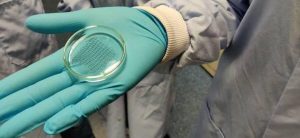
New polymer patch can mend a broken heart
Canadian Plastics
3D Printing Materials Research & DevelopmentBioengineers at the Trinity College in Dublin have developed a prototype polymer-based patch that could be used to repair damaged heart tissue following a heart attack.

The prototype patch was manufactured via a reproducible, accurate, and scalable melt electrowriting process. Photo Credit: Trinity College
Generations of poets, playwrights, and songwriters – not to mention ordinary frustrated romantics – have wondered what it takes to mend a broken heart. Turns out the answer might actually be found in Ireland.
Bioengineers at the Trinity College in Dublin have developed a prototype polymer-based patch that does the same job as crucial aspects of heart tissue, raising the potential for it to replace scar tissue caused by a heart attack. A paper describing the research was published in the Feb. 12, 2020 edition of the journal Advanced Functional Materials.
When a heart attack occurs, some of the cardiac tissue that performs the task of contraction ends up being replaced with non-beating scar tissue, which permanently compromises the function of the heart.
But the new polymer structure patch can correct the defects caused by this scar tissue. And it goes where no polymer has gone before. Until now, polyester-based thermoplastic polymers – which are predominantly the approved options for biomedical applications – haven’t been able to meet the mechanical demands of heart muscle (or myocardium). But the patch developed by the Trinity researchers is made of a medically-approved stretchable polymermaterial and is coated with a mesh of a separate electroconductive polymer – known as polypyrrole – to provide electrical conductivity while maintaining cell compatibility.
Manufactured through a melt electrowriting process – a reproducible, accurate, and scalable form of 3D printing developed by Trinity spinoff company Spraybase – the polymer patch is intended to be attached to the outside of the heart, bridging an area of scar tissue. The researchers believe that, once implanted on the heart, the patch will be able to pick up the electrical signals of the surrounding cardiac cells, transmitting their signals across the gap; and that it will have the elasticity to withstand repeated stretching, which is a dominant concern for cardiac biomaterials.
“Essentially, our material addresses a lot of requirements,” senior author Michael Monaghan, an assistant professor at Trinity, said in a news release. “The bulk material is currently approved for medical device use, the design accommodates the movement of the pumping heart, and has been functionalized to accommodate signaling between isolated contractile tissues. This study currently reports the development of our method and design, but we are now looking forward to furthering the next generation of designs and materials with the eventual aim of applying this patch as a therapy for a heart attack.”
The ultimate goal is for the patch not only to be able to restore heart tissue in patients who have had damaged tissue removed after a heart attack, but also to repair congenital heart defects in infants and children.
So far, the Trinity research team has tested the patch in a lab environment on isolated pieces of biological tissue. They’re now planning for animal trials.
Source: Trinity College
